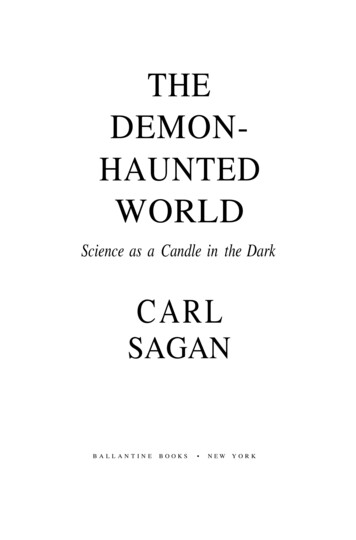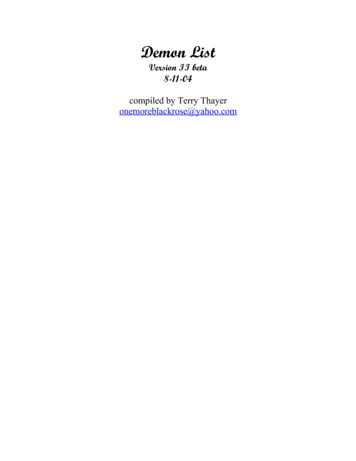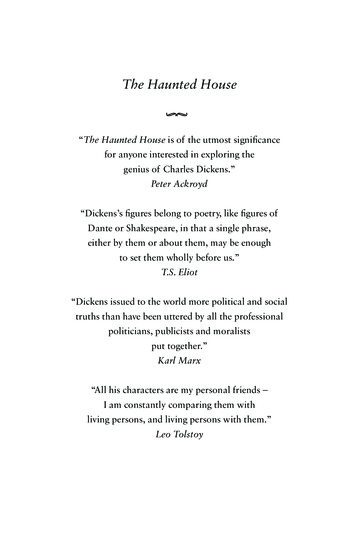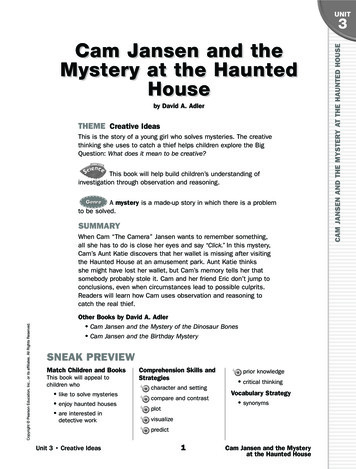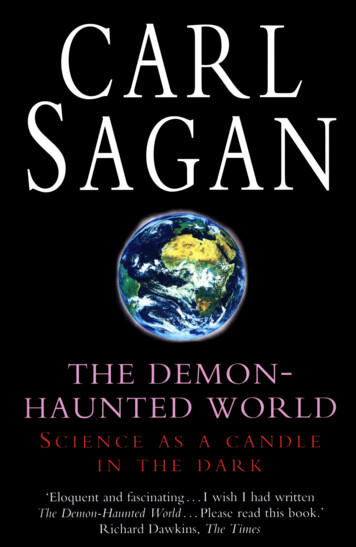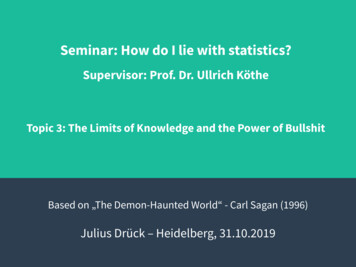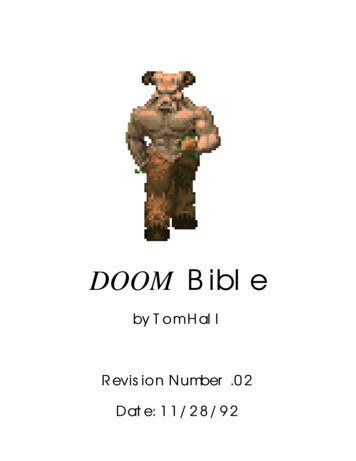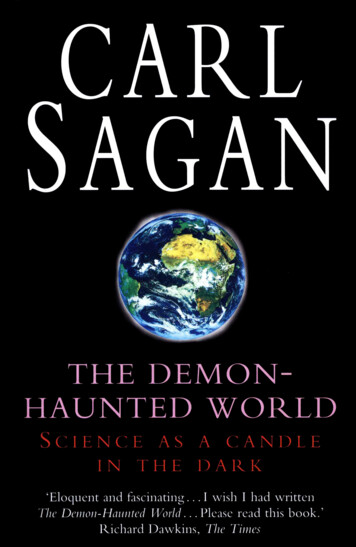
Transcription
THE DEMON-HAUNTED WORLDCarl Sagan is the David Duncan Professor of Astronomyand Space Sciences and Director of the Laboratory forPlanetary Studies at Cornell University; DistinguishedVisiting Scientist at the Jet Propulsion Laboratory,California Institute of Technology; and co-founder andPresident of The Planetary Society, the largest spaceinterest group in the world.For his work, Dr Sagan has been awarded the NASAMedals for Exceptional Scientific Achievement and(twice) for Distinguished Public Service, as well as theNASA Apollo Achievement Award. Asteroid 2709 Saganis named after him.
This is the twenty-ninth book Carl Sagan has authored,co-authored or edited. Some of his other books:Intelligent Life in the Universe(with I. S. Shklovskii)The Dragons of EdenBroca's BrainCosmosContact: A NovelComet(with Ann Druyan)A Path Where No Man Thought:Nuclear Winter and the End of the Arms Race(with Richard Turco)Shadows of Forgotten Ancestors:A Search for Who We Are(with Ann Druyan)Pale Blue Dot:A Vision of the Human Future in Space
TheDemon-HauntedWorldScience as a Candlein the DarkCarl SaganHEADLINE
Copyright 1997 Carl SaganThe right of Carl Sagan to be identified as the Author ofthe Work has been asserted by him in accordance with theCopyright, Designs and Patents Act 1988.First published in 1996by HEADLINE BOOK PUBLISHINGFirst published in this edition in 1997by HEADLINE BOOK PUBLISHING10 9 8 7 6 5 4All rights reserved. No part of this publication may bereproduced, stored in a retrieval system, or transmitted,in any form or by any means without the prior writtenpermission of the publisher, nor be otherwise circulatedin any form of binding or cover other than that in whichit is published and without a similar condition beingimposed on the subsequent purchaser.ISBN 0 7472 5156 8Typeset byLetterpart Limited, Reigate, SurreyPrinted and bound in Great Britain byClays Ltd, St Ives plcHEADLINE BOOK PUBLISHINGA division of Hodder Headline PLC338 Euston RoadLondon NW1 3BH
To Tonio,My grandson.I wish you a worldFree of demonsAnd full of light.
We wait for light, but behold darkness.Isaiah 59:9It is better to light one candle than to curse the darkness.Adage
ce: My TeachersThe Most Precious ThingScience and HopeThe Man in the Moon and the Face on MarsAliensSpoofing and SecrecyHallucinationsThe Demon-Haunted WorldOn the Distinction between True and False VisionsTherapyThe Dragon in My GarageThe City of GriefThe Fine Art of Baloney DetectionObsessed with RealityAntiscienceNewton's SleepWhen Scientists Know SinThe Marriage of Scepticism and WonderThe Wind Makes DustNo Such Thing as a Dumb QuestionHouse on Fire*The Path to Freedom*Significance JunkiesMaxwell and The 290300318333345355
2425Science and Witchcraft*Real Patriots Ask Questions*AcknowledgementsReferencesIndex* Written with Ann Druyan377396409412427
PrefaceMy TeachersIt was a blustery fall day in 1939. In the streets outside theapartment building, fallen leaves were swirling in little whirlwinds, each with a life of its own. It was good to be inside andwarm and safe, with my mother preparing dinner in the nextroom. In our apartment there were no older kids who picked onyou for no reason. Just the week before, I had been in a fight - Ican't remember, after all these years, who it was with; maybe itwas Snoony Agata from the third floor - and, after a wild swing, Ifound I had put my fist through the plate glass window ofSchechter's drug store.Mr Schechter was solicitous: 'It's all right, I'm insured,' he saidas he put some unbelievably painful antiseptic on my wrist. Mymother took me to the doctor whose office was on the groundfloor of our building. With a pair of tweezers, he pulled out afragment of glass. Using needle and thread, he sewed two stitches.'Two stitches!' my father had repeated later that night. He knewabout stitches, because he was a cutter in the garment industry; hisjob was to use a very scary power saw to cut out patterns - backs,say, or sleeves for ladies' coats and suits - from an enormous stackof cloth. Then the patterns were conveyed to endless rows ofwomen sitting at sewing machines. He was pleased I had gottenangry enough to overcome a natural timidity.Sometimes it was good to fight back. I hadn't planned to doanything violent. It just happened. One moment Snoony was1
THE DEMON-HAUNTED WORLDpushing me and the next moment my fist was through MrSchechter's window. I had injured my wrist, generated an unexpected medical expense, broken a plate glass window, and no onewas mad at me. As for Snoony, he was more friendly than ever.I puzzled over what the lesson was. But it was much morepleasant to work it out up here in the warmth of the apartment,gazing out through the living-room window into Lower New YorkBay, than to risk some new misadventure on the streets below.As she often did, my mother had changed her clothes and madeup her face in anticipation of my father's arrival. We talked aboutmy fight with Snoony. The Sun was almost setting and together welooked out across the choppy waters.'There are people fighting out there, killing each other,' shesaid, waving vaguely across the Atlantic. I peered intently.'I know,' I replied. 'I can see them.''No, you can't,' she replied, sceptically, almost severely, beforereturning to the kitchen. 'They're too far away.'How could she know whether I could see them or not? Iwondered. Squinting, I had thought I'd made out a thin strip ofland at the horizon on which tiny figures were pushing and shovingand duelling with swords as they did in my comic books. But maybeshe was right. Maybe it had just been my imagination, a little likethe midnight monsters that still, on occasion, awakened me from adeep sleep, my pyjamas drenched in sweat, my heart pounding.How can you tell when someone is only imagining? I gazed outacross the grey waters until night fell and I was called to wash myhands for dinner. When he came home, my father swooped me upin his arms. I could feel the cold of the outside world against hisone-day growth of beard.On a Sunday in that same year, my father had patiently explainedto me about zero as a placeholder in arithmetic, about thewicked-sounding names of big numbers, and about how there's nobiggest number ('You can always add one,' he pointed out).Suddenly, I was seized by a childish compulsion to write insequence all the integers from 1 to 1,000. We had no pads ofpaper, but my father offered up the stack of grey cardboards hehad been saving from when his shirts were sent to the laundry. I2
My Teachersstarted the project eagerly, but was surprised at how slowly itwent. When I had gotten no farther than the low hundreds, mymother announced that it was time for me to take my bath. I wasdisconsolate. I had to get a thousand. A mediator his whole life,my father intervened: if I would cheerfully submit to the bath, hewould continue the sequence. I was overjoyed. By the time Iemerged, he was approaching 900, and I was able to reach 1,000only a little past my ordinary bedtime. The magnitude of largenumbers has never ceased to impress me.Also in 1939 my parents took me to the New York World's Fair.There, I was offered a vision of a perfect future made possible byscience and high technology. A time capsule was buried, packedwith artefacts of our time for the benefit of those in the far future who, astonishingly, might not know much about the people of1939. The 'World of Tomorrow' would be sleek, clean, streamlined and, as far as I could tell, without a trace of poor people.'See sound' one exhibit bewilderingly commanded. And sureenough, when the tuning fork was struck by the little hammer, abeautiful sine wave marched across the oscilloscope screen. 'Hearlight' another poster exhorted. And sure enough, when theflashlight shone on the photocell, I could hear something like thestatic on our Motorola radio set when the dial was betweenstations. Plainly the world held wonders of a kind I had neverguessed. How could a tone become a picture and light become anoise?My parents were not scientists. They knew almost nothingabout science. But in introducing me simultaneously to scepticismand to wonder, they taught me the two uneasily cohabiting modesof thought that are central to the scientific method. They wereonly one step out of poverty. But when I announced that I wantedto be an astronomer, I received unqualified support - even if they(as I) had only the most rudimentary idea of what an astronomerdoes. They never suggested that, all things considered, it might bebetter to be a doctor or a lawyer.I wish I could tell you about inspirational teachers in sciencefrom my elementary or junior high or high school days. But as Ithink back on it, there were none. There was rote memorizationabout the Periodic Table of the Elements, levers and inclined3
T H E DEMON-HAUNTED WORLDplanes, green plant photosynthesis, and the difference betweenanthracite and bituminous coal. But there was no soaring sense ofwonder, no hint of an evolutionary perspective, and nothing aboutmistaken ideas that everybody had once believed. In high schoollaboratory courses, there was an answer we were supposed to get.We were marked off if we didn't get it. There was no encouragement to pursue our own interests or hunches or conceptualmistakes. In the backs of textbooks there was material you couldtell was interesting. The school year would always end before wegot to it. You could find wonderful books on astronomy, say, inthe libraries, but not in the classroom. Long division was taught asa set of rules from a cookbook, with no explanation of how thisparticular sequence of short divisions, multiplications and subtractions got you the right answer. In high school, extracting squareroots was offered reverentially, as if it were a method once handeddown from Mt Sinai. It was our job merely to remember what wehad been commanded. Get the right answer, and never mind thatyou don't understand what you're doing. I had a very capablesecond-year algebra teacher from whom I learned much mathematics; but he was also a bully who enjoyed reducing youngwomen to tears. My interest in science was maintained through allthose school years by reading books and magazines on science factand fiction.College was the fulfilment of my dreams: I found teachers whonot only understood science, but who were actually able to explainit. I was lucky enough to attend one of the great institutions oflearning of the time, the University of Chicago. I was a physicsstudent in a department orbiting around Enrico Fermi; I discovered what true mathematical elegance is from SubrahmanyanChandrasekhar; I was given the chance to talk chemistry withHarold Urey; over summers I was apprenticed in biology to H.J.Muller at Indiana University; and I learned planetary astronomyfrom its only full-time practitioner at the time, G.P. Kuiper.It was from Kuiper that I first got a feeling for what is called aback-of-the-envelope calculation: a possible explanation to aproblem occurs to you, you pull out an old envelope, appeal toyour knowledge of fundamental physics, scribble a few approximate equations on the envelope, substitute in likely numerical4
My Teachersvalues, and see if your answer comes anywhere near explainingyour problem. If not, you look for a different explanation. It cutthrough nonsense like a knife through butter.At the University of Chicago I also was lucky enough to gothrough a general education programme devised by Robert M.Hutchins, where science was presented as an integral part of thegorgeous tapestry of human knowledge. It was consideredunthinkable for an aspiring physicist not to know Plato, Aristotle,Bach, Shakespeare, Gibbon, Malinowski and Freud - amongmany others. In an introductory science class, Ptolemy's view thatthe Sun revolved around the Earth was presented so compellinglythat some students found themselves re-evaluating their commitment to Copernicus. The status of the teachers in the Hutchinscurriculum had almost nothing to do with their research; perversely - unlike the American university standard of today teachers were valued for their teaching, their ability to inform andinspire the next generation.In this heady atmosphere, I was able to fill in some of the manygaps in my education. Much that had been deeply mysterious, andnot just in science, became clearer. I also witnessed at first handthe joy felt by those whose privilege it is to uncover a little abouthow the Universe works.I've always been grateful to my mentors of the 1950s, and triedto make sure that each of them knew my appreciation. But as Ilook back, it seems clear to me that I learned the most essentialthings not from my school teachers, nor even from my universityprofessors, but from my parents, who knew nothing at all aboutscience, in that single far-off year of 1939.5
1The Most Precious ThingAll our science, measured against reality, is primitive andchildlike - and yet it is the most precious thing we have.Albert Einstein (1879-1955)As I got off the plane, he was waiting for me, holding up ascrap of cardboard with my name scribbled on it. I was onmy way to a conference of scientists and TV broadcasters devotedto the seemingly hopeless prospect of improving the presentationof science on commercial television. The organizers had kindlysent a driver.'Do you mind if I ask you a question?' he said as we waited formy bag.No, I didn't mind.'Isn't it confusing to have the same name as that scientist guy?'It took me a moment to understand. Was he pulling my leg?Finally, it dawned on me.'I am that scientist guy,' I answered.He paused and then smiled. 'Sorry. That's my problem. Ithought it was yours too.'He put out his hand. 'My name is William F. Buckley.' (Well,he wasn't exactly William F. Buckley, but he did bear the name ofa contentious and well-known TV interviewer, for which hedoubtless took a lot of good-natured ribbing.)As we settled into the car for the long drive, the windshield6
The Most Precious Thingwipers rhythmically thwacking, he told me he was glad I was 'thatscientist guy' - he had so many questions to ask about science.Would I mind?No, I didn't mind.And so we got to talking. But not, as it turned out, aboutscience. He wanted to talk about frozen extraterrestrials languishing in an Air Force base near San Antonio, 'channelling' (a way tohear what's on the minds of dead people - not much, it turns out),crystals, the prophecies of Nostradamus, astrology, the shroud ofTurin . . . He introduced each portentous subject with buoyantenthusiasm. Each time I had to disappoint him:'The evidence is crummy,' I kept saying. 'There's a muchsimpler explanation.'He was, in a way, widely read. He knew the various speculativenuances on, let's say, the 'sunken continents' of Atlantis andLemuria. He had at his fingertips what underwater expeditionswere supposedly just setting out to find the tumbled columns andbroken minarets of a once-great civilization whose remains werenow visited only by deep sea luminescent fish and giant kraken.Except . . . while the ocean keeps many secrets, I knew that thereisn't a trace of oceanographic or geophysical support for Atlantisand Lemuria. As far as science can tell, they never existed. Bynow a little reluctantly, I told him so.As we drove through the rain, I could see him getting glummerand glummer. I was dismissing not just some errant doctrine, but aprecious facet of his inner life.And yet there's so much in real science that's equally exciting,more mysterious, a greater intellectual challenge - as well as beinga lot closer to the truth. Did he know about the molecular buildingblocks of life sitting out there in the cold, tenuous gas between thestars? Had he heard of the footprints of our ancestors found in4-million-year-old volcanic ash? What about the raising of theHimalayas when India went crashing into Asia? Or how viruses,built like hypodermic syringes, slip their DNA past the hostorganism's defences and subvert the reproductive machinery ofcells; or the radio search for extraterrestrial intelligence; or thenewly discovered ancient civilization of Ebla that advertised thevirtues of Ebla beer? No, he hadn't heard. Nor did he know, even7
THE DEMON-HAUNTED WORLDvaguely, about quantum indeterminacy, and he recognized DNAonly as three frequently linked capital letters.Mr 'Buckley' - well-spoken, intelligent, curious - had heardvirtually nothing of modern science. He had a natural appetite forthe wonders of the Universe. He wanted to know about science.It's just that all the science had gotten filtered out before itreached him. Our cultural motifs, our educational system, ourcommunications media had failed this man. What society permitted to trickle through was mainly pretence and confusion. It hadnever taught him how to distinguish real science from the cheapimitation. He knew nothing about how science works.There are hundreds of books about Atlantis - the mythicalcontinent that is said to have existed something like 10,000 yearsago in the Atlantic Ocean. (Or somewhere. A recent book locatesit in Antarctica.) The story goes back to Plato, who reported it ashearsay coming down to him from remote ages. Recent booksauthoritatively describe the high level of Atlantean technology,morals and spirituality, and the great tragedy of an entire populated continent sinking beneath the waves. There is a 'New Age'Atlantis, 'the legendary civilization of advanced sciences,' chieflydevoted to the 'science' of crystals. In a trilogy called CrystalEnlightenment by Katrina Raphaell - the books mainly responsible for the crystal craze in America - Atlantean crystals readminds, transmit thoughts, are the repositories of ancient historyand the model and source of the pyramids of Egypt. Nothingapproximating evidence is offered to support these assertions. (Aresurgence of crystal mania may follow the recent finding by thereal science of seismology that the inner core of the Earth may becomposed of a single, huge, nearly perfect crystal - of iron.)A few books - Dorothy Vitaliano's Legends of the Earth, forexample - sympathetically interpret the original Atlantis legendsin terms of a small island in the Mediterranean that was destroyedby a volcanic eruption, or an ancient city that slid into the Gulf ofCorinth after an earthquake. This, for all we know, may be thesource of the legend, but it is a far cry from the destruction of acontinent on which had sprung forth a preternaturally advancedtechnical and mystical civilization.What we almost never find - in public libraries or newsstand8
The Most Precious Thingmagazines or prime-time television programmes - is the evidencefrom sea floor spreading and plate tectonics, and from mappingthe ocean floor which shows quite unmistakably that there couldhave been no continent between Europe and the Americas onanything like the timescale proposed.Spurious accounts that snare, the gullible are readily available.Sceptical treatments are much harder to find. Scepticism does notsell well. A bright and curious person who relies entirely onpopular culture to be informed about something like Atlantis ishundreds or thousands of times more likely to come upon a fabletreated uncritically than a sober and balanced assessment.Maybe Mr Buckley should know to be more sceptical aboutwhat's dished out to him by popular culture. But apart from that,it's hard to see how it's his fault. He simply accepted what themost widely available and accessible sources of informationclaimed was true. For his naivete, he was systematically misledand bamboozled.Science arouses a soaring sense of wonder. But so does pseudoscience. Sparse and poor popularizations of science abandonecological niches that pseudoscience promptly fills. If it werewidely understood that claims to knowledge require adequateevidence before they can be accepted, there would be no room forpseudoscience. But a kind of Gresham's Law prevails in popularculture by which bad science drives out good.All over the world there are enormous numbers of smart, evengifted, people who harbour a passion for science. But that passionis unrequited. Surveys suggest that some 95 per cent of Americansare 'scientifically illiterate'. That's just the same fraction as thoseAfrican Americans, almost all of them slaves, who were illiteratejust before the Civil War - when severe penalties were in force foranyone who taught a slave to read. Of course there's a degree ofarbitrariness about any determination of illiteracy, whether itapplies to language or to science. But anything like 95 per centilliteracy is extremely serious.Every generation worries that educational standards are decaying. One of the oldest short essays in human history, dating fromSumer some 4,000 years ago, laments that the young are disastrously more ignorant than the generation immediately preceding.9
THE DEMON-HAUNTED WORLDTwenty-four hundred years ago, the ageing and grumpy Plato, inBook VII of the Laws, gave his definition of scientific illiteracy:Who is unable to count one, two, three, or to distinguish oddfrom even numbers, or is unable to count at all, or reckonnight and day, and who is totally unacquainted with therevolution of the Sun and Moon, and the other stars . . . Allfreemen, I conceive, should learn as much of these branchesof knowledge as every child in Egypt is taught when he learnsthe alphabet. In that country arithmetical games have beeninvented for the use of mere children, which they learn aspleasure and amusement . . . I . . . have late in life heardwith amazement of our ignorance in these matters; to me weappear to be more like pigs than men, and I am quiteashamed, not only of myself, but of all Greeks.I don't know to what extent ignorance of science and mathematicscontributed to the decline of ancient Athens, but I know that theconsequences of scientific illiteracy are far more dangerous in ourtime than in any that has come before. It's perilous and foolhardyfor the average citizen to remain ignorant about global warming,say, or ozone depletion, air pollution, toxic and radioactivewastes, acid rain, topsoil erosion, tropical deforestation, exponential population growth. Jobs and wages depend on science andtechnology. If our nation can't manufacture, at high quality andlow price, products people want to buy, then industries willcontinue to drift away and transfer a little more prosperity toother parts of the world. Consider the social ramifications offission and fusion power, supercomputers, data 'highways', abortion, radon, massive reductions in strategic weapons, addiction,government eavesdropping on the lives of its citizens, highresolution TV, airline and airport safety, foetal tissue transplants,health costs, food additives, drugs to ameliorate mania or depression or schizophrenia, animal rights, superconductivity, morningafter pills, alleged hereditary antisocial predispositions, spacestations, going to Mars, finding cures for AIDS and cancer.How can we affect national policy - or even make intelligentdecisions in our own lives - if we don't grasp the underlying10
The Most Precious Thingissues? As I write, Congress is dissolving its own Office ofTechnology Assessment - the only organization specifically taskedto provide advice to the House and Senate on science andtechnology. Its competence and integrity over the years have beenexemplary. Of the 535 members of the US Congress, rarely in thetwentieth century have as many as one per cent had any significantbackground in science. The last scientifically literate Presidentmay have been Thomas Jefferson.*So how do Americans decide these matters? How do theyinstruct their representatives? Who in fact makes these decisions,and on what basis?Hippocrates of Cos is the father of medicine. He is still remembered2,500 years later for the Hippocratic Oath (a modified form of whichis still here and there taken by medical students upon their graduation). But he is chiefly celebrated because of his efforts to bringmedicine out of the pall of superstition and into the light of science.In a typical passage Hippocrates wrote: 'Men think epilepsy divine,merely because they do not understand it. But if they calledeverything divine which they do not understand, why, there wouldbe no end of divine things.' Instead of acknowledging that in manyareas we are ignorant, we have tended to say things like the Universeis permeated with the ineffable. A God of the Gaps is assignedresponsibility for what we do not yet understand. As knowledge ofmedicine improved since the fourth century BC, there was more andmore that we understood and less and less that had to be attributedto divine intervention - either in the causes or in the treatment ofdisease. Deaths in childbirth and infant mortality have decreased,lifetimes have lengthened, and medicine has improved the quality oflife for billions of us all over the planet.In the diagnosis of disease, Hippocrates introduced elementsof the scientific method. He urged careful and meticulous* Although claims can be made for Theodore Roosevelt, Herbert Hoover andJimmy Carter. Britain had such a Prime Minister in Margaret Thatcher. Herearly studies in chemistry, in part under the tutelage of Nobel laureate DorothyHodgkin, were key to the UK's strong and successful advocacy that ozonedepleting CFCs be banned worldwide.11
THE DEMON-HAUNTED WORLDobservation: 'Leave nothing to chance. Overlook nothing.Combine contradictory observations. Allow yourself enoughtime.' Before the invention of the thermometer, he charted thetemperature curves of many diseases. He recommended thatphysicians be able to tell, from present symptoms alone, theprobable past and future course of each illness. He stressedhonesty. He was willing to admit the limitations of the physician'sknowledge. He betrayed no embarrassment in confiding to posterity that more than half his patients were killed by the diseases hewas treating. His options of course were limited; the drugsavailable to him were chiefly laxatives, emetics and narcotics.Surgery was performed, and cauterization. Considerable furtheradvances were made in classical times through to the fall of Rome.While medicine in the Islamic world flourished, what followedin Europe was truly a dark age. Much knowledge of anatomy andsurgery was lost. Reliance on prayer and miraculous healingabounded. Secular physicians became extinct. Chants, potions,horoscopes and amulets were widely used. Dissections of cadaverswere restricted or outlawed, so those who practised medicine wereprevented from acquiring first-hand knowledge of the humanbody. Medical research came to a standstill.It was very like what the historian Edward Gibbon described forthe entire Eastern Empire, whose capital was Constantinople:In the revolution of ten centuries, not a single discovery wasmade to exalt the dignity or promote the happiness of mankind.Not a single idea had been added to the speculative systems ofantiquity, and a succession of patient disciples became in theirturn the dogmatic teachers of the next servile generation.Even at its best, pre-modern medical practice did not save many.Queen Anne was the last Stuart monarch of Great Britain. In the lastseventeen years of the seventeenth century, she was pregnanteighteen times. Only five children were born alive. Only one of themsurvived infancy. He died before reaching adulthood, and before hercoronation in 1702. There seems to be no evidence of some geneticdisorder. She had the best medical care money could buy.Diseases that once tragically carried off countless infants and12
The Most Precious Thingchildren have been progressively mitigated and cured by science through the discovery of the microbial world, via the insight thatphysicians and midwives should wash their hands and sterilizetheir instruments, through nutrition, public health and sanitationmeasures, antibiotics, drugs, vaccines, the uncovering of themolecular structure of DNA, molecular biology, and now genetherapy. In the developed world at least, parents today have anenormously better chance of seeing their children live to adulthood than did the heir to the throne of one of the most powerfulnations on Earth in the late seventeenth century. Smallpox has beenwiped out worldwide. The area of our planet infested with malariacarrying mosquitoes has dramatically shrunk. The number of years achild diagnosed with leukaemia can expect to live has been increasing progressively, year by year. Science permits the Earth to feedabout a hundred times more humans, and under conditions muchless grim, than it could a few thousand years ago.We can pray over the cholera victim, or we can give her 500milligrams of tetracycline every twelve hours. (There is still areligion, Christian Science, that denies the germ theory of disease; ifprayer fails, the faithful would rather see their children die than givethem antibiotics.) We can try nearly futile psychoanalytic talktherapy on the schizophrenic patient, or we can give him 300 to 500milligrams a day of chlozapine. The scientific treatments are hundreds or thousands of times more effective than the alternatives.(And even when the alternatives seem to work, we don't actuallyknow that they played any role: spontaneous remissions, even ofcholera and schizophrenia, can occur without prayer and withoutpsychoanalysis.) Abandoning science means abandoning much morethan air conditioning, CD players, hair dryers and fast cars.In hunter-gatherer, pre-agricultural times, the human lifeexpectancy was about 20 to 30 years. That's also what it was inWestern Europe in Late Roman and in Medieval times. It didn'trise to 40 years until around the year 1870. It reached 50 in 1915,60 in 1930, 70 in 1955, and is today approaching 80 (a little morefor women, a little less for men). The rest of the wor
THE DEMON-HAUNTED WORLD planes, green plant photosynthesis, and the difference between anthracite and bituminous coal. But there was no soaring sense of wonder, no hint of an evolutionary perspective, and nothing about mistaken ideas that everybody had once believed. In high school laborat


